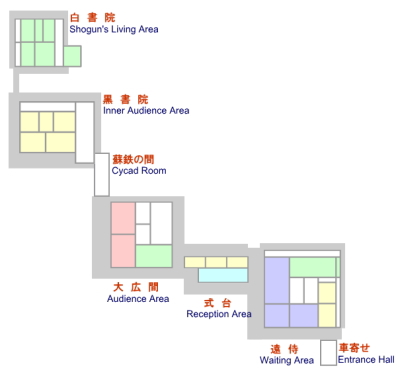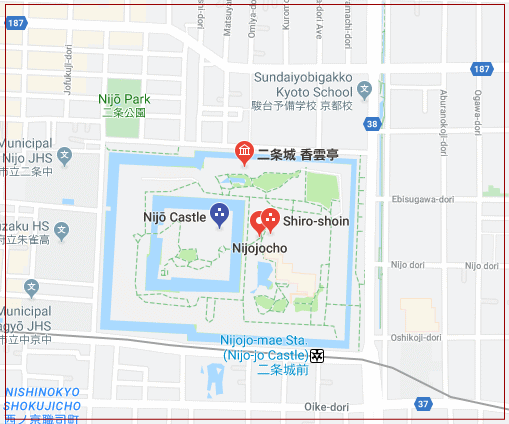As a Man Who Would Wait for a Bird to Sing...
So he did wait. On March 12, 1603, Tokugawa Ieyasu took his first step into a brand-new Nijō Castle building, which had been built as his lodging in Kyoto and just completed in the previous month. He had been appointed as Seii Taishōgun (lit. Barbarian-conquering great shogun), virtually the commander-in-chief of all military forces in the country, by the Imperial Court in the last February. Finally, he had become the de-facto ruler of Japan. A special celebration was held at Nijō Castle, inviting principal vassals and the Kuge (those serving at the Imperial Court) on March 27. He was 60 years old, a late bloomer compared with the other two contemporary leaders: Oda Nobunaga and Toyotomi Hideyoshi.
There is a set of three quotes people today often use to represent these three warrior lords:
Just kill it, if a cuckoo won’t sing
(Nakanu nara koroshite shimae hototogisu)
Make it sing if a cuckoo won’t sing
(Nakanu nara nakashite mishō hototogisu)
Wait until it sings, if a cuckoo won’t sing
(Nakanu nara nakumade matoō hototogisu)
Guess who said which? Apparently, as a late flower, Ieyasu would utter the third, while the first and second define Nobunaga and Hideyoshi, respectively. Indeed, Ieyasu took his time and knew how to be patient. Or probably, he had no other choice but to do so.
He was born in December 26, 1542 in Okazaki Castle in Mikawa Province (present Aichi Prefecture) as the first son of the castle's lord and named Takechiyo. When he was three, his mother Lady Odai left him, because she was divorced for a political reason. Takechiyo’s loneliness even intensified, when he was sent under the custody of the Imagawa family as their hostage to Sunpu Province. The clan was the then ally committed to protecting his family and home province.
In 1560, he finally returned to his native castle. He was 19 then. Released from the custody of Imagawa, he allied with Oda Nobunaga, the former enemy of the house, in the following year. In 1582, the Honnōji Incident occurred and Nobunaga died. Then, he helped Hashiba Hideyoshi (later his surname changed to Toyotomi) unify the country as his faithful vassal. In 1598, Hideyoshi died. His chance finally came, by winning the Battle of Sekigahara and becomming the ruler of Japan in 1600. After serving two masters, his could hear his cuckoo sing.
Yoshinobu Closing the Tokugawa Bakufu
More than two centuries had passed. The 15th and last shogun of the Edo Bakufu, Tokugawa Yoshinobu summoned representatives of Han (Domains) dwelling in Kyoto to this Nijō Castle. He was about to make a historic announcement on this day, October 13, 1867, following a proposal by Yamauchi Yōdō, the lord of Tosa Domain. In front of 40 domain ministers congregating, he announced Taisei Hōkan or Handover of Authority to the Emperor, technically ending the 265-year shogunate initiated by Ieyasu.
After Yoshinobu retired into a quiet, hobby-pursuing life, the castle became a property of the imperial family and changed its name to "Nijō Detached Palace" in 1884. In 1939, it was donated to Kyoto city and renamed Nijō Castle, and has been open for public viewing since then.
Guardhouse Important Cultural Property
Passing through the Higashi Ōte Mon (Eastern Main Gate), you will see a long (19.6 m) and narrow building with samurai mannequins (posing as guards) sitting or standing upright. Called Bansho in Japanese, the structure served as a guardhouse, where guards used to regulate and welcome visitors to the castle.
The guards were specially called Nijō Zaiban (Nijō Guards) and dispatched far from Edo (present Tokyo). There were a hundred of Nijō Zaiban in those days, split into two groups containing 50 and working on yearly shifts: one replacing another every April.
Once there were many such guard stations throughout the castle, but this one (at Higashi Ōte Mon) is the only one remaining today. For its rarity, the house is listed as Japan's Important Cultural Property, serving as a valuable historical reference.
Ninomaru Palace National Treasure
Going through the Kara Mon (Chinese-style gate), here you are at the Ninomaru (Outer Fortress) Palace. Featuring a typical Shoin style of the Azuchi Momoyama Period (1568 - 1600), the palace comprises five units: the Entrance/Waiting Area, Reception Area, Audience Area, Kuro Shoin (Inner Audience Chamber) and Shiro Shoin (Shogun’s Quarters). Well, let’s think number-wise. The entire area measures 3,300 square metres, and there are 33 rooms or 800 tatami mats (one tatami mat measures 985 mm x 1,970 mm).
Now step inside the Ninomaru Palace, remove your shoes (just like in any ordinary Japanese house) and start walking on the wooden corridor. And listen to a warbler squeaking! It's heard beneath the floor as you walk. Called Uguisu Bari (Nightingale floor), it's compared to the chirping of Uguisu (Japanese bush warbler). So what’s this for? To entertain visitors? Think hard, and you know the answer!
While being amused by the Nightingale squeaking as a modern visitor, you can take a glimpse of ostentatious palace life. The paintings on the Fusuma (sliding doors) and walls of each room are masterpieces by celebrated contemporary artists of the famous Kanō School. The rooms are decorated with a sophisticated set of Shoin style decoration items including beautifully-carved Ranma transoms, chic Toko No Ma alcoves, decorative doors, and even Kugi Kakushi (nail head covers) of flower designs. The palace buildings are listed as a National Treasure item.
PLAN OF NINOMARU PALACE (Click for details)

Ninomaru Garden Special Scenery
After chirping around inside the palace, it’s time for fresh air in the Ninomaru Garden! Just like many famous Japanese gardens, this is a Chisen Kaiyushiki Teien (a garden built around a pond), a trendy garden style in the Edo Period (1603 - 1867). Placing a pond at the centre surrounded by trees, as well as rocks in various sizes compared to islands, the design represents a Buddha land. This garden is designed by a renown tea master and garden architect Kobori Enshū.
Whatever the season, you can stroll around the garden to enjoy natural beauty. When you come closer to the pond, just look at its centre. There are three islands called Hōrai Jima (Island of Eternal Happiness), Tsuru Jima (Crane Island), and Kame Jima (Tortois Island). While the first name sounds happy, you may wonder why cranes or tortoises? Suffice to say it is believed in Japan that cranes live a thousand years and tortoises, ten thousand!
Honmaru Building Important Cultural Property
The Honmaru (Inner Fortress) Palace is located to the west of the Ninomaru Palace. But this is not the original one because it was burned down by a big fire in 1788. The present building was brought from the Kyoto Imperial Palace premises in 1893. Formerly used as a palace for Prince Katsura, an imperial member, it’s equally valuable and prestigious as the original palace, and listed as an Important Cultural Property item. But it's not currently open to the public.
By the way, the original palace was built by the third shogun Iemitsu in 1626, incorporating Momoyama style structures transferred from Fushimi Castle, and was used as a residence for him and his retainers.
There’s something destroyed in 1750, struck by lightning. It was a magnificent five-tier donjon, which used to stand in the current Honmaru area. To the south of the palace and southwest of the ex-donjon site, there is a garden created in the Meiji Period (1868 - 1912).
Seiryu En Garden
Now you may have seen enough of Nijo Castle and ready to leave. But wait! Here’s another garden to the north of the Ninomaru Palace. Called Seiryu En and completed in 1965, it represents an atmosphere of “magnificence, brightness and elegance” combined. This 16,500 square-meter garden showcases a traditional Japanese garden design and western lawn field harmoniously combined.
Decorating the garden are 1,100 rocks, and stones are indispensable to creating Japanese gardens. 800 of them have been brought from the nearby residence of Ryoi Suminokura, a wealthy merchant at the beginning of the Edo Period and the remaining 300 stones were from throughout Japan.
Within the garden, there are two tea houses; Ka Un Tei (lit. Fragrant Clouds House) and Waraku An (lit. Harmony Comfort Hut). The cottages are mainly used for tea ceremonies held by the city or reception events for government guests.
|






